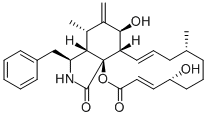Home
Products
Cytochalasin B



| Product Name | Cytochalasin B |
| Price: | Inquiry |
| Catalog No.: | CN00906 |
| CAS No.: | 14930-96-2 |
| Molecular Formula: | C29H37NO5 |
| Molecular Weight: | 479.61 g/mol |
| Purity: | >=98% |
| Type of Compound: | Alkaloids |
| Physical Desc.: | Powder |
| Source: | The seed culture of solid wheat. |
| Solvent: | Chloroform, Dichloromethane, Ethyl Acetate, DMSO, Acetone, etc. |
| SMILES: | C[C@@H]1CCC[C@@H](O)/C=C/C(=O)O[C@@]23[C@@H](/C=C/C1)[C@H](O)C(=C)[C@H]([C@H]3[C@@H](NC2=O)Cc1ccccc1)C |
| Contact us | |
|---|---|
| First Name: | |
| Last Name: | |
| E-mail: | |
| Question: | |
| Description | Cytochalasin B is a cell-permeable mycotoxin binding to the barbed end of actin filaments, disrupting the formation of actin polymers, with Kd value of 1.4-2.2 nM for F-actin. |
| Target | Kd: 2.2 nM (F-actin, with Mg2+), 1.4 nM (F-actin, with Mg2+/K+)[1] |
| In Vitro | Cytochalasin B is a cell-permeable mycotoxin binding to the barbed end of actin filaments, inhibits the enlongation and shortening of actin filaments, with Kds of 2.2 nM and 1.4 nM for F-actin in the presence of MgCl2 (2 mM) or MgCl2 (2 mM) plus KCl, respectively[1]. Cytochalasin B (0.1-10 μM) shows inhibitory effect on multiple murine cancer cell lines, with IC50s of 2.56 μM (M109c), 10.46 μM (B16BL6), 105.5 μM (P388/ADR), 51.9 μM (P388/S) and IC80s of 12.23 μM (M109c), 44.86 μM (B16BL6), 188.4 μM (P388/ADR), 84.1 μM (P388/S) after treatment for 3 h, with IC50s of 0.25 μM (M109c), 0.37 μM (B16F10), 0.87 μM (B16BL6), and IC80s of 0.75 μM (M109c), 1.21 μM (B16F10), 10.41 μM (B16BL6) after treatment for 4 days[2]. Cytochalasin B (6 μM) increases the myofibrillar fragmentation index (MFI), which is attributed to the intensely breaking of myofibrillar proteins into short segments. Cytochalasin B also accelerates the disruption of actin filaments. In addition, Cytochalasin B accelerates the transformation from F-actin to G-actin, lowering the content of F-actin and significantly increasing G-actin bands during postmortem conditioning[3]. |
| In Vivo | Cytochalasin B (10, 25, 50 mg/kg, i.p.) dose-dependently increases the life expectancy of Balb/c mice bearing with P388/ADR leukemias. Cytochalasin B at 50 mg/kg produces 10 % long-term survival in the multidrug resistant P388/ADR cohort, and 40 % long-term survival in the drug sensitive P388/S cohort[2]. |
| Cell Assay | The attached cell lines M109c, B16BL6, and B16F10 are seeded at 1 to 4 × 104 cells/mL in 2 mL volumes in 24-well culture plates 1 day prior to treatment with Cytochalasin B. The suspension culture of P388/ADR cells is seeded at 5 × 104 cells/mL and allowed to grow overnight before Cytochalasin B treatment. Cells are treated with Cytochalasin B for 3 h, as well as 2, 3, or 4 days. In the case of continuous exposure for 2, 3, or 4 days, attached cells are trypsinized and counted with a hemacytometer. Leukemia cell suspensions are counted with a Coulter Counter. In the case of short-term exposure, cells are washed twice with fresh medium, then trypsinized (except for P388/ADR cells), reseeded, and allowed to regrow for 3 days, at which time they are counted. Growth results are calculated as the number of cells generated above the seeding density compared to the untreated control cells and graphically presented as percent of control increase[2]. |
| Animal Admin | Mice[2] For chemotherapy testing, Balb/c mice under isoflurane anesthesia are challenged with 2 × 105 trypan blue negative P388/S or P388/ADR cells subcutaneously (s.c.) in a volume of 200 μL. Untreated mice are kept in order to determine the lethality of the challenge without chemotherapeutic intervention. Long-term survival is defined as challenged mice that survive the duration of the observation period. Cytochalasins B and D are prepared in suspension form in 2 % carboxymethyl cellulose 1 % tween 20 (CMC/Tw) for intraperitoneal (i.p.) administration. The congeners or the vehicle are administered to leukemia-challenged mice on Days 1-8 following the initial challenge[2]. |
| Density | 1.2±0.1 g/cm3 |
| Boiling Point | 740.6±60.0 °C at 760 mmHg |
| Flash Point | 401.7±32.9 °C |
| Exact Mass | 479.267181 |
| PSA | 95.86000 |
| LogP | 3.71 |
| Vapour Pressure | 0.0±2.6 mmHg at 25°C |
| Storage condition | −20°C |